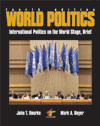The rapid global increase in the number of gasoline-powered vehicles and the rapid decrease in the world's number of trees add to the buildup of carbon dioxide (CO2) in the atmosphere. As a mathematical equation, this might be written (vehicles) + (trees) = + CO2. The problem with this equation is, many scientists worry, is that it is contributing to global warming. The elements of the equation are not complex. The number of vehicles in the world has risen from about 70 million in 1945 to about 650 million. Analysts predict that there will be one billion vehicles on the world's roads in 2025. Most of this increase will come as the LDCs improve their standard of living. There are in the United States about 750 vehicles for every 1,000 people. By contrast, for every 1,000 people, China has only eight vehicles and India just seven. If the people of China and India were today as well-off as the average American, there would be yet another 1.6 billion cars (+ 246 percent) on the road. The Chinese and Indians are, of course, a long way from the American standard of living, but the future may hold a car or several cars in every Chinese and Indian driveway and garage. Even the 650 million vehicles being driven today emit an immense amount of CO2. According to the U.S. Environmental Protection Agency (EPA), a small, fuel-efficient Geo Metro emits 9,200 pounds of CO2 a year (based on 15,000 miles). A Ford F-150 pickup truck emits 18,500 pounds of CO2, and a Dodge Durango, one of the popular sport utility vehicles, discharges 21,100 pounds of CO2 annually. Trees are another part of the equation. They are the environmental antithesis of vehicles in that they convert CO2 to oxygen. Unfortunately for the atmosphere, the number of trees have been decreasing as vehicles have been increasing. As noted earlier in this chapter, the forests that remain today are only about half the size of the forests that once were. Inasmuch as a large tree can absorb and convert up to 48 pounds of CO2 into oxygen annually, the loss of billions of trees has vastly diminished the ability of the Earth to cleanse itself of excess CO2. What is complex is how to balance the equation, that is, how to achieve sustainable development. Yet there may be some relatively simple guidelines available by plugging numbers into the equation. To wit, in terms of CO2 conversion to oxygen per tree, 1 Geo Metro = 200 trees. Similarly, 1 Ford F-150 = 385 trees, and 1 Dodge Durango = 440 trees. Sustainable development, then, requires less vehicles (or vehicles that are less polluting), or more trees, or some combination thereof. The current formula of more vehicles and less trees is likely to lead to the wrong answer. An equation something like (vehicles) + (less polluting vehicles) +
(trees) is likely to yield a better result. |



 2002 McGraw-Hill Higher Education
2002 McGraw-Hill Higher Education